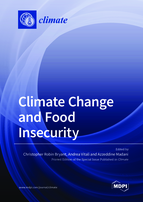Climate Change and Food Insecurity
A special issue of Climate (ISSN 2225-1154).
Deadline for manuscript submissions: closed (31 January 2022) | Viewed by 64566
Special Issue Editors
Interests: the adaptation of human activities to climatic change, especially agriculture; sustainable community development; rural development; land use planning; strategic management/planning of development including agriculture; community participation; the dynamics and planning of urban agriculture; including pioneer work on adaptation behavior under stressful conditions; sustainable transport policies
Special Issues, Collections and Topics in MDPI journals
Interests: cattle; heat stress; animal welfare; GHG emissions; environmental sustainability; mitigation and adaptation to climate change
Special Issues, Collections and Topics in MDPI journals
Interests: sustainable transport policies; adaptation to climate change in land transport; adaptation of cities to climate change; transport and town planning relationship; mobility; fight against traffic accidents; health geography; smart and green cities; pedestrian and bicycle mobility; new forms of governance
Special Issues, Collections and Topics in MDPI journals
Special Issue Information
Dear Colleagues,
Food Insecurity has rapidly become a major issue in many countries in the last 10 years. Food Insecurity has impacted many people in many contexts, such as Developing countries for example in many African states, but as well we can find significant food insecurity issues in many developed countries, sometimes in some of the rural territories located far from major cities but as well Food Insecure populations embedded in urban contexts within cities. Food Insecurity is linked to accessibility (costs and ease of access to healthy foodstuffs) and inevitably to neighborhoods in cities and rural territories where the populations are poor. Climate change can have major effects upon food production and can potentially reduce food production to the point where local populations are in danger of not having access to enough foodstuff at reasonable costs.This Special Issue is interested in a number of issues: how has climate change had major negative impacts on Food Insecurity either in urban neighborhoods or in rural agricultural territories. Furthermore, what are the ways in which this Food Insecurity created by climate change can be remedied, e.g. through modifications in the manner in which foodstuffs (crops as well as foodstuffs of animal origin) are produced, how social organizations can create conditions in which healthy foodstuffs can be made available to poor communities in cities or in rural territories by involving reasonably well-off populations contributing to lowering the prices of foodstuffs made available to poor populations. Many of the initiatives can be created by groups of citizens and by groups of farmers who wish to contribute to reducing Food Insecurity created by climate change and by other factors such as rising costs of foodstuffs to poor consumers.
Prof. Dr. Christopher R. Bryant
Prof. Dr. Andrea Vitali
Dr. Azzeddine Madani
Guest Editors
Manuscript Submission Information
Manuscripts should be submitted online at www.mdpi.com by registering and logging in to this website. Once you are registered, click here to go to the submission form. Manuscripts can be submitted until the deadline. All submissions that pass pre-check are peer-reviewed. Accepted papers will be published continuously in the journal (as soon as accepted) and will be listed together on the special issue website. Research articles, review articles as well as short communications are invited. For planned papers, a title and short abstract (about 100 words) can be sent to the Editorial Office for announcement on this website.
Submitted manuscripts should not have been published previously, nor be under consideration for publication elsewhere (except conference proceedings papers). All manuscripts are thoroughly refereed through a single-blind peer-review process. A guide for authors and other relevant information for submission of manuscripts is available on the Instructions for Authors page. Climate is an international peer-reviewed open access monthly journal published by MDPI.
Please visit the Instructions for Authors page before submitting a manuscript. The Article Processing Charge (APC) for publication in this open access journal is 1800 CHF (Swiss Francs). Submitted papers should be well formatted and use good English. Authors may use MDPI's English editing service prior to publication or during author revisions.
Keywords
- food insecurity
- poor populations in rural territories
- poor neighborhoods in many cities
- climate change and its negative effects upon the volume of healthy foodstuffs available
- climate change and its potential to modify the production of accessible foodstuffs cost wise and simply from the perspective of the volume of healthy foodstuffs
- solutions to increasing the production of healthy foodstuffs despite climate change
- the roles of different actors such as farmers, urban gardeners, social organizations, governments of different types








